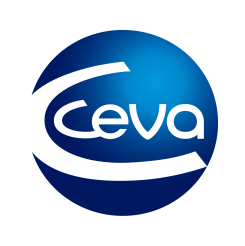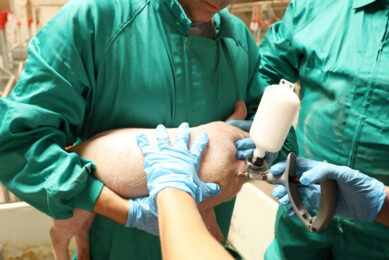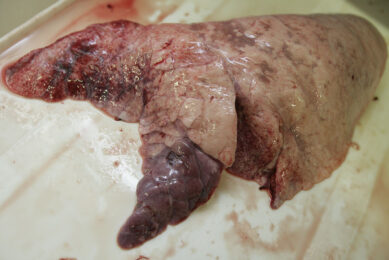Neonatal diarrhoea: An emerging problem on farms
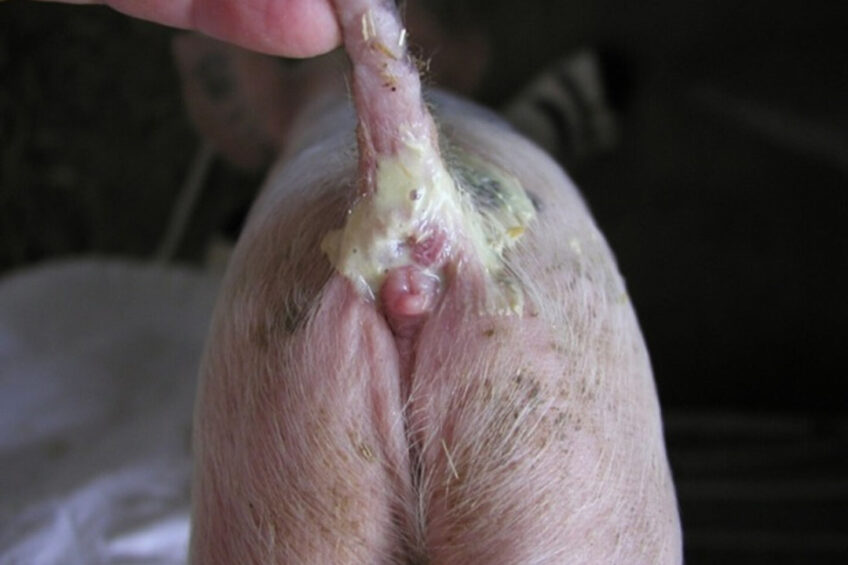
Neonatal diarrhoea (ND) is one of the most common problems in modern pig production. In recent years, pig production has changed and intensification has increased, resulting in increased numbers of animals of hyperprolific genetics requiring changes in management, particularly in the farrowing house.
A higher degree of intensification has contributed to the increased occurrence of ND, which causes significant economic losses (mortality and negative effect on performance parameters) and excessive use of antimicrobials. The frequency of ND cases has increased in EU countries in recent years, affecting both farms with conventional health status as well as farms with high health status after repopulation. Estimated costs for herds affected by ND with estimated mortality of 10% caused by disease can be as high as € 134 per sow per year (Table 1). Together with swine dysentery, ND is one of the most costly enteric infections on pig farms.
Pathogens of the neonatal diarrhoea complex
By definition, ND is characterised by diarrhoea, usually accompanied by consequent mortality, that develops during the first week of the piglets’ lives. Occurrence and severity of ND can be influenced by numerous factors and involve a number of pathogens including ETEC (Enterotoxigenic Escherichia coli) strains of E. coli and Clostridium perfringens types A and C. ETEC responsible for ND has adhesins, surface proteins called fimbriae, identified as F4, F5, F6 and, less frequently, F41. The fimbriae allow the micro-organism to adhere to specific receptors on the brush borders of the small intestine’s enterocytes. The most prevalent ETEC with the fimbriae F4 colonises the length of the jejunum and ileum, causing diarrhoea.
C. perfringens type A (CpA) has been recognised in numerous studies as one of the most important pathogens causing ND, therefore focus has been placed on its effective control. CpA is included in the microbiota of the swine intestine, and properly equipped strains are able to cause enteric disease. Infection of piglets is characterised by mild inflammation of the mucosa, occasionally with adherent necrotic material. Microscopic lesions may include superficial damage of epithelial tips of the villi of the small intestine during the first days of life. Other pathogens can be involved in cases of ND, together with contributing management factors.
Role of C. perfringens A and specific toxins
A recently published study using samples from a monitoring program in different European countries evaluated the occurrence of pathogens in the faeces of piglets suffering from neonatal diarrhoea (ND) in 2020. In the bacteriological examination of the samples from 116 farms, the most frequently isolated bacterial pathogens were E. coli (48.6%), followed by C. perfringens (33.9%). The typing of the C. perfringens isolates revealed, that they all belonged to C. perfringens type A (CPA). 90.6% of them carried the coding genes for both the α- and ß2-toxin, and therefore showed a high virulence potential. The analysis of their semi-quantitative detection revealed that 79.4% of the E. coli isolates occurred in a moderate or high content, and even 96.7% of C. perfringens isolates, suggesting their role in pathogenesis of diarrhoea. In piglets, CpA causes enteropathy after substantial multiplication, which is sometimes accompanied by the adherence of Clostridia to the gut mucosa. All strains of CpA produce principal toxin CPA (alpha toxin) in varying quantities. Beta2 toxin is another important toxin, frequently produced by strains of CpA causing diarrhoea in piglets. Many authors suggest that Beta2 toxin plays a role in causing the enteric infection in pigs, but also in other animal species. Gene detection and presence of the Beta2 toxin gene is used for diagnostics and characterisation of strains that cause diarrhoea in piglets and was proposed as a marker of pathogenicity
Role of Beta2 toxin
The majority of isolates of CpA from clinical cases contain Beta2 toxin gene, suggesting its role in pathogenesis of ND in piglets. In the author’s own investigations where all isolates were collected from clinical cases of ND during the identification of vaccination candidates, 94.2% of the C. perfringens strains investigated belonged to type A, and 87.9% of the isolates were also positive for the β2 toxin gene (cpb2). Strains with a low or average α toxin-forming capacity often displayed significant formation of the β2 toxin in vitro. It is suggested that there is a synergistic effect of both toxins based on an improvement in the intake of the α toxin by the β2 toxin with the negative effect on intestinal mucosa and its integrity. At the same time, in intoxication trials it was shown that vaccinated sows form antibodies to both toxins – α and β2 – which are transferred to their offspring via the colostrum and play a role in protection. This was demonstrated during registration of the new vaccine against ND containing seven different antigens, including both alpha and beta2 toxoids (Enteroporc Coli AC, Ceva Santé Animale, France).
Figure 1 – Dominant role of isolates of CpA positive for Beta2 toxin from clinical cases of ND. Number and percentage isolates with ß2-toxin gene and without from a total of 117 isolates by country of origin. Number of isolates per country in brackets.
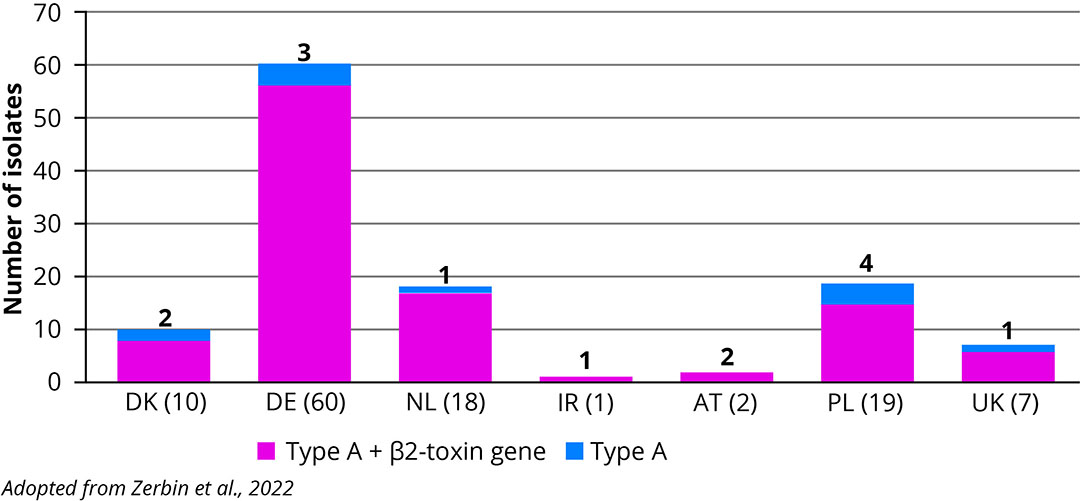
Efficacy of vaccination against CpA under field conditions
The objective of the present trial was to test the efficacy of the C. perfringens type A (CpA) component of a licensed C. perfringens type A/C toxoid vaccine (Enteroporc AC) under field conditions. During the trial (Figure 2), piglets of 16 vaccinated and 18 control gilts were followed until 26 days of age. Vaccination under field conditions led to an increase of antibodies against alpha and Beta2 toxins in the serum and colostrum of the gilts and resulted in a significant (p < 0.05) reduction of the incidence of diarrhoea: total 38.7% of piglets (84/217) from vaccinated gilts with diarrhoea vs. 62.6% piglets (161/257) from control gilts. The efficacy and protection induced by the vaccine were demonstrated under field conditions in the case of CpA infection, non-complicated by other pathogens involved in ND.
Figure 2 – Significant reduction of diarrhoea rate in vaccinated piglets compared with control.
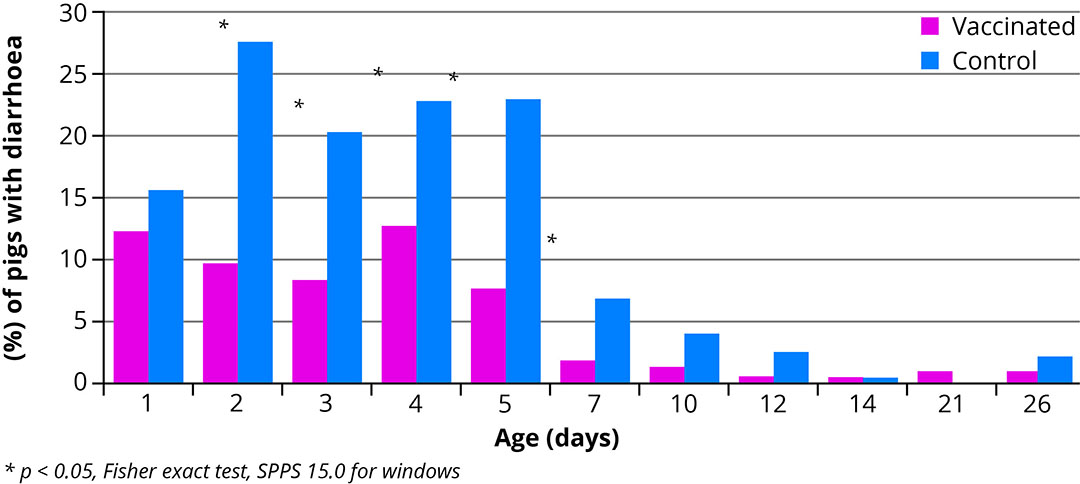
Conclusion
Cpb2-positive C. perfringens type A strains are commonly found in piglets suffering from diarrhoea and play an important role in cases of ND. Based on laboratory analysis focused on quantification of the pathogen, 96.7% of C. perfringens type A isolates grow at moderate or high rates, suggesting their role in clinical cases submitted for diagnosis.
The use of a commercial C. perfringens type A vaccine with both toxoids led to the formation of antibodies to the α and β2 toxins in the colostrum, which protected the piglets against the effects of the aforementioned toxins and emphasises the role of vaccination against the pathogen and ND complex. Preventive medicine programmes should focus on the protection of piglets before weaning involving the vaccination of gestating sows to induce passive transfer of antibodies and cellular immunity to the piglets via colostrum.
References are available on request.


